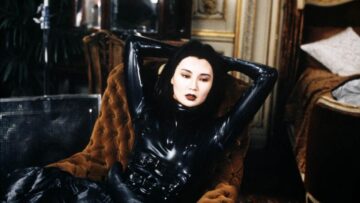During the planning of Irma Vep, The Last Breath, exhibition curator Nina Bozicnik exchanged emails with artist Michelle Handelman about the exhibition's themes of queer subjectivity, criminal anxiety, and claiming space for difference. Read, enjoy, consider, and come see the multi-screen video installation when it opens on July 11th!
Nina Bozicnik: You've mentioned elsewhere that you were drawn to the character of Irma Vep for her outlaw presence, slinking covertly through Paris in a black bodysuit. Why this interest in the clandestine figure?
Michelle Handelman: I would say that the destabilizing of representation is imperative for gaining new knowledge. Irma Vep's outfit both reveals and conceals, giving her a fluidity that allows her to operate outside of the confines of acceptable female behavior. In my work, I use the non-predictive body in the way of the trickster questioning where the "I" is located. As my Irma says near the end of the piece, "We're all transcendental beings aren't we . . . I mean the body is just a shell, a layer, a carcass."
NB: You play with shadows, masking, artifice, and the unreliability of appearances. Why make this space for uncertainty?
MH: In Irma Vep, The Last Breath I'm specifically looking at my experiences of being part of a subculture and living life undercover and thinking about what we give up for "freedom." I cast Zackary Drucker as Irma Vep because as a trans woman she knows about living life undercover on a daily basis, about passing. I refer to passing as not just tied to gender or racial identity, but as a strategy we all use to try to "pass" as socialized human beings. Jack Doroshow a.k.a. Flawless Sabrina, who plays Musidora, grew up as a gay man during the 1950s and also knows a thing or two about living undercover, both as protection and as a way of life.
NB: In Irma Vep, The Last Breath you delve deep into the fears and anxieties of your main character, the criminal Irma Vep. What motivated you to explore this dark psychology?
MH: From the beginning I've made work that's highly personal, a pouring out of my own existential questioning. Losing people I loved at a young age, finding myself escaping through drugs, trying to climb out of a big black void, these are the experiences that inform my work. How do we go on when we're surrounded by so much pain and nothingness? And where do we find meaning? I cast Jack as Musidora because Jack stands as a testament to survival, and I think the most meaningful things we have are our stories of survival. Here is a man who against all odds was not killed by AIDS, was not killed by fagbashers, and has lived and continues to live a life that combines pleasure and political intent.
NB: Knowing you have an interest in the spatial dimension of cinema, how are you working with the Henry's architecture to create an immersive experience?
MH: At the Henry we'll be envisioning a new configuration that plays with scale and brings lighting elements from the film's production design into the space. We'll also be showing two galleries of photographs from the project that have never been seen before. These galleries are meant to be like the calm before the storm, a space of contemplation and transcendence before entering the dark psychology of the film installation. There's this relentless quality in my work that grabs hold and won't let go. You can't escape the shimmering vacuity of the human experience.


![<p>Michelle Handelman. <i>Irma Vep, The Last Breath</i> [production still: Laure Leber]. 2013. 4-channel video installation (color, sound); 37:00 minutes. Image courtesy of the artist.</p>](https://henryart.org/assets/img/_smallImage/IrmaVep_4.jpg)



